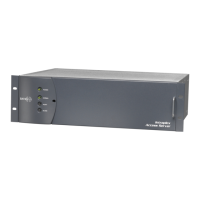ACS-160 Series & STL-160 Series T1 Multiplexer Installation & Operation 5 – Remote Control
Version 2.11, August 2011
5-42 Harris Corporation
Intraplex Products
Evaluate CSU_STAT? and REMOTE_STAT? Responses
The CSU_STAT? and REMOTE_STAT? commands request the same data format from the local and
remote ends of your network, respectively. This example is a typical response to the CSU_STAT?
and REMOTE_STAT? commands:
* OK
ELAPS TIME 19:52:30
DETEC TIME 19:52:30
CRC=1 0
1<CRC<=5 0
5<CRC<=10 0
10<CRC<=100 0
100<CRC<=319 0
CRC>320 0
SEFE SEC 0
FBE SEC 0
BPV SEC 0
SLIP SEC 0
PLB SEC 0
YEL SEC 0
Table 5-22 describes the data in a CSU_STAT? and REMOTE_STAT? response.
Table 5-22. CSU_STAT? and REMOTE_STAT? Response Data
Data Description Typical Value
ELAPS TIME Elapse Time - The time the integrated CSU has been
accumulating CSU line performance data
DETEC TIME Detection Time - The time the integrated CSU has been
successfully receiving (REMOTE_STAT? command) or
sending (CSU_STAT? command) ANSI T1.403 compatible
performance report messages from the remote device.
When the local/remote
device is ANSI-compliant,
DETEC TIME = ELAPS TIME
When the local/remote
device is neither ANSI- or
AT&T-compliant and a signal
is present, DETEC TIME
remains constant at 0:00
CRC=1 CRC error events - The occurrence of a received CRC code
that is not identical to the corresponding locally-calculated
code
Under normal operating
conditions, you should not
have any CRC errors. The
more CRC errors
accumulated the greater the
severity of the problem. CRC
> 320 is equivalent to a
severely errored second.
1<CRC<=5
5<CRC<=10
10<CRC<=100
100<CRC<=319
CRC>320
SEFE SEC Severely errored framing event seconds - The occurrence of
two or more framing-bit-pattern errors within a 3
millisecond period. Contiguous 3 millisecond intervals are
examined and the 3 millisecond period may coincide with
the ESF. This framing-error indicator, while similar in form
to criteria for declaring a terminal has lost framing, is only
designed as a performance indicator; existing terminal out-
of-frame criteria are the basis for terminal alarms.
Under normal operating
conditions, you should not
have any SEFE seconds.
FBE SEC Framing synchronization bit error seconds - The occurrence
of a frame-bit error in the received frame-bit pattern.
Under normal operating
conditions, you should not
have any FBE seconds.

